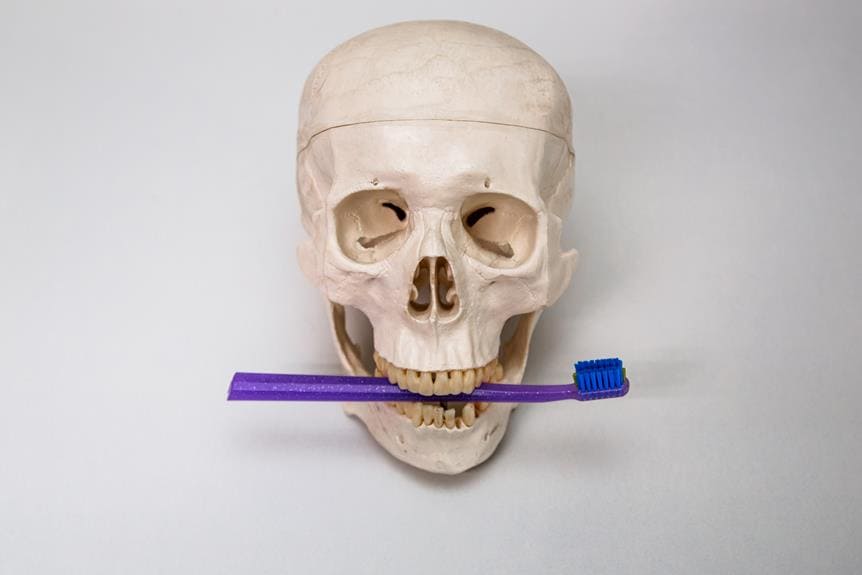What Is Osteoporosis and How to Prevent Bone Loss

In a world where mobility and independence are highly valued, maintaining strong and healthy bones is crucial. Osteoporosis, a condition characterized by weak and brittle bones, poses a significant threat to our overall well-being.
However, there is hope. By understanding the causes and risk factors of osteoporosis and implementing preventive measures, we can take control of our bone health.
In this article, we will explore what osteoporosis is and delve into effective strategies to prevent bone loss, ensuring a future of strength and vitality.
Key Takeaways
- Osteoporosis is primarily caused by a combination of genetic and lifestyle factors.
- Symptoms of osteoporosis include bone pain and fractures, especially in the wrist, hip, or spine.
- Sufficient calcium and vitamin D intake, along with a balanced diet and regular exercise, are crucial for maintaining strong bones.
- Medications and alternative therapies can help prevent bone loss and reduce fracture risk, but personalized treatment plans are important for effectiveness.
Understanding Osteoporosis: Causes and Risk Factors
While there are several factors that contribute to the development of osteoporosis, understanding its causes and risk factors is crucial for effective prevention and management.
Osteoporosis is primarily caused by a combination of genetic and lifestyle factors. Family history, age, and gender play a significant role in determining an individual's risk of developing osteoporosis. Other risk factors include low calcium and vitamin D intake, sedentary lifestyle, smoking, excessive alcohol consumption, certain medical conditions, and the use of certain medications.
Prevention and management of osteoporosis involve a multifaceted approach. Adequate calcium and vitamin D intake, regular weight-bearing exercises, maintaining a healthy body weight, and avoiding smoking and excessive alcohol consumption are essential for preventing bone loss.
Additionally, early diagnosis and treatment through medications, hormone therapy, and lifestyle modifications can help slow down the progression of osteoporosis and reduce the risk of fractures.
Recognizing the Symptoms of Osteoporosis
The recognition of symptoms, such as bone pain and fractures, is crucial in the early detection and management of osteoporosis. Symptoms awareness plays a significant role in identifying individuals who may be at risk for this condition. By being aware of the common symptoms associated with osteoporosis, individuals can seek medical attention and receive appropriate treatment before the disease progresses.
Bone pain, especially in the back or hips, can be an early sign of osteoporosis. Fractures, particularly in the wrist, hip, or spine, may also indicate the presence of this condition. Understanding these symptoms is vital in order to prevent further bone loss and maintain overall bone health.
Transitioning into the subsequent section, the role of nutrition in preventing bone loss will be explored in greater detail.
The Role of Nutrition in Preventing Bone Loss
To better understand the role of nutrition in preventing bone loss, it is essential to analyze the impact of dietary choices and the correlation between nutrient intake and bone health. Nutritional supplements can play a significant role in maintaining bone density and preventing bone loss. However, it is important to consult with a healthcare professional before starting any supplement regimen.
In addition to supplements, following dietary recommendations that include sufficient calcium and vitamin D intake is crucial for maintaining strong bones. Consuming a balanced diet that incorporates foods rich in these nutrients, such as dairy products, leafy greens, and fatty fish, can help support bone health.
Furthermore, incorporating regular physical activity and weight-bearing exercises into one's routine can further enhance bone strength and prevent bone loss. Transitioning into the subsequent section about 'building strong bones: exercise and physical activity', it is important to understand how these factors work together to promote overall bone health.
Building Strong Bones: Exercise and Physical Activity
Regular exercise and physical activity play a crucial role in building strong bones.
Weight-bearing exercises, such as walking, jogging, or dancing, are particularly important as they help stimulate the bones to become stronger.
Additionally, a sedentary lifestyle can negatively impact bone health, making it essential to incorporate regular exercise into our daily routines.
Weight-Bearing Exercises: Importance
Importantly, weight-bearing exercises play a crucial role in building and maintaining strong bones. Regular participation in weight-bearing activities not only helps strengthen bones but also provides several other benefits for overall health and well-being. Here are five key advantages of incorporating weight-bearing exercises into your routine:
- Improved bone density: Weight-bearing exercises stimulate the bones to become stronger and denser, reducing the risk of osteoporosis and fractures.
- Enhanced muscle strength: These exercises help build and maintain muscle strength, which is essential for stability, balance, and preventing falls.
- Increased joint stability: Weight-bearing activities promote joint stability and flexibility, reducing the risk of joint pain and injury.
- Boosted metabolism: Engaging in weight-bearing exercises can increase metabolism, helping with weight management and overall energy expenditure.
- Improved cardiovascular health: Many weight-bearing exercises, such as walking, jogging, or dancing, also provide cardiovascular benefits, improving heart health and reducing the risk of chronic diseases.
Sedentary Lifestyle: Bone Health?
The sedentary lifestyle has a significant impact on bone health, affecting the strength and density of bones. When individuals engage in a sedentary lifestyle, which involves prolonged sitting or inactivity, their bones are not subjected to the necessary stress and strain required for proper bone development and maintenance.
As a result, bone density decreases, making bones more susceptible to fractures and conditions such as osteoporosis. It is crucial for individuals with a sedentary lifestyle to implement strategies for increasing physical activity to mitigate the negative effects on bone health.
These strategies can include incorporating regular weight-bearing exercises, such as walking or jogging, into their daily routine, as well as participating in activities that promote balance and flexibility, such as yoga or tai chi. By making these lifestyle changes, individuals can improve their bone density and overall bone health, reducing the risk of fractures and other bone-related issues.
Lifestyle Habits That Promote Bone Health
Adopting a well-balanced diet rich in calcium and vitamin D is crucial for promoting bone health. A healthy diet that includes these essential nutrients can help prevent bone loss and reduce the risk of osteoporosis. Regular exercise is another important habit that promotes bone health. Engaging in weight-bearing exercises like walking, jogging, or dancing can strengthen bones and improve bone density. Limiting alcohol consumption is also important for bone health. Excessive alcohol intake can interfere with the body's ability to absorb calcium, leading to weakened bones. Similarly, avoiding smoking is crucial for maintaining strong bones. Smoking has been linked to increased bone loss and a higher risk of fractures. Getting enough sunlight is another habit that promotes bone health. Vitamin D, which is essential for calcium absorption, can be obtained from sunlight. Spending time outdoors can help ensure adequate vitamin D levels. Lastly, maintaining a healthy body weight is important for overall bone health. Being underweight or overweight can increase the risk of bone loss and fracture. By incorporating these habits into one's lifestyle, individuals can take proactive steps towards promoting their own bone health and serving as an example for others.
Medical Interventions and Treatments for Osteoporosis
To effectively manage osteoporosis, healthcare providers may recommend a combination of medication therapy and lifestyle adjustments.
Medical treatments for osteoporosis include various medications that can help slow down bone loss and reduce the risk of fractures. These medications work by either increasing bone density or reducing the rate of bone breakdown. Commonly prescribed medications include bisphosphonates, selective estrogen receptor modulators (SERMs), hormone replacement therapy (HRT), and denosumab.
However, healthcare providers may also discuss alternative therapies with patients as a complementary approach to traditional medical treatments. These alternative therapies may include dietary supplements such as calcium and vitamin D, exercise and physical therapy, as well as natural remedies like herbal supplements.
It is important for healthcare providers to have open discussions with their patients to develop a personalized treatment plan that takes into consideration the individual's preferences and needs.
Frequently Asked Questions
Can Osteoporosis Be Completely Prevented With a Healthy Lifestyle and Proper Nutrition?
Osteoporosis prevention requires a healthy lifestyle and proper nutrition. While these factors can significantly reduce the risk, complete prevention may not be possible. However, adopting a well-balanced diet and engaging in weight-bearing exercises can help maintain bone health and reduce the likelihood of developing osteoporosis.
Are There Any Specific Exercises or Physical Activities That Should Be Avoided to Prevent Bone Loss?
To prevent bone loss and strengthen bones, it is important to engage in weight-bearing exercises such as walking, jogging, and weightlifting. Avoiding a sedentary lifestyle and incorporating physical activity can positively impact bone health.
Can Osteoporosis Be Reversed Through Medical Interventions and Treatments?
Reversing osteoporosis through medical interventions is a complex process that requires a multidisciplinary approach. Various treatments, such as medication, hormone therapy, and lifestyle modifications, can help slow down bone loss and improve bone density.
Is Osteoporosis More Common in Men or Women?
Osteoporosis prevalence is higher in women due to specific risk factors such as hormonal changes during menopause and lower peak bone mass. Understanding these differences can aid in developing effective prevention strategies and interventions.
Are There Any Alternative Treatments or Natural Remedies That Can Help Prevent or Treat Osteoporosis?
Alternative therapies and herbal remedies can be considered as potential options for preventing or treating osteoporosis. These natural approaches, when used in conjunction with conventional methods, may offer additional support in maintaining bone health and reducing the risk of fractures.








